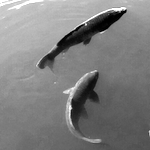Micro-scale swimming robots are of great potential to operate in confined space with minimal invasion. To solve the energy-supply, propulsion and control issues for micro-scale swimming robots, programed external magnetic field is usually used in their drive and control. A magnetic drive micro-scale swimming robot usually consist of a magnetic core that receive the external force applied by the magnetic field, as well as elastic body parts that enable flapping/undulating propulsion.
Due to the complicated physical process in the deformation of robot structure and the interaction between robot and surrounding fluids, it is difficult to accurately predict the kinematics and motion in a magnetic drive soft robot.
To this end, we developed an integrated numerical approach with fluid-structure-motion interaction. The numerical approach consists of three coupled modules, respectively solving fluid, elastic structure deformation and robot body's free-motion. The three modules provide boundary conditions and other information to support the running of each other. Besides the initial properties of the swimmer and fluid such as morphological, material, density and fluid viscosity parameters, the only required external information for the integrated model is the information of the magnetic field.
The integrated numerical approach accurately predicts the motion of the magnetic drive soft robot, enabling us to evaluate the swimming pattern and propulsive performance of the robot virtually. The integrated numerical approach may also open up new vistas in our understanding of fish swimming behavior and hydrodynamics.

 PDF version
PDF version
